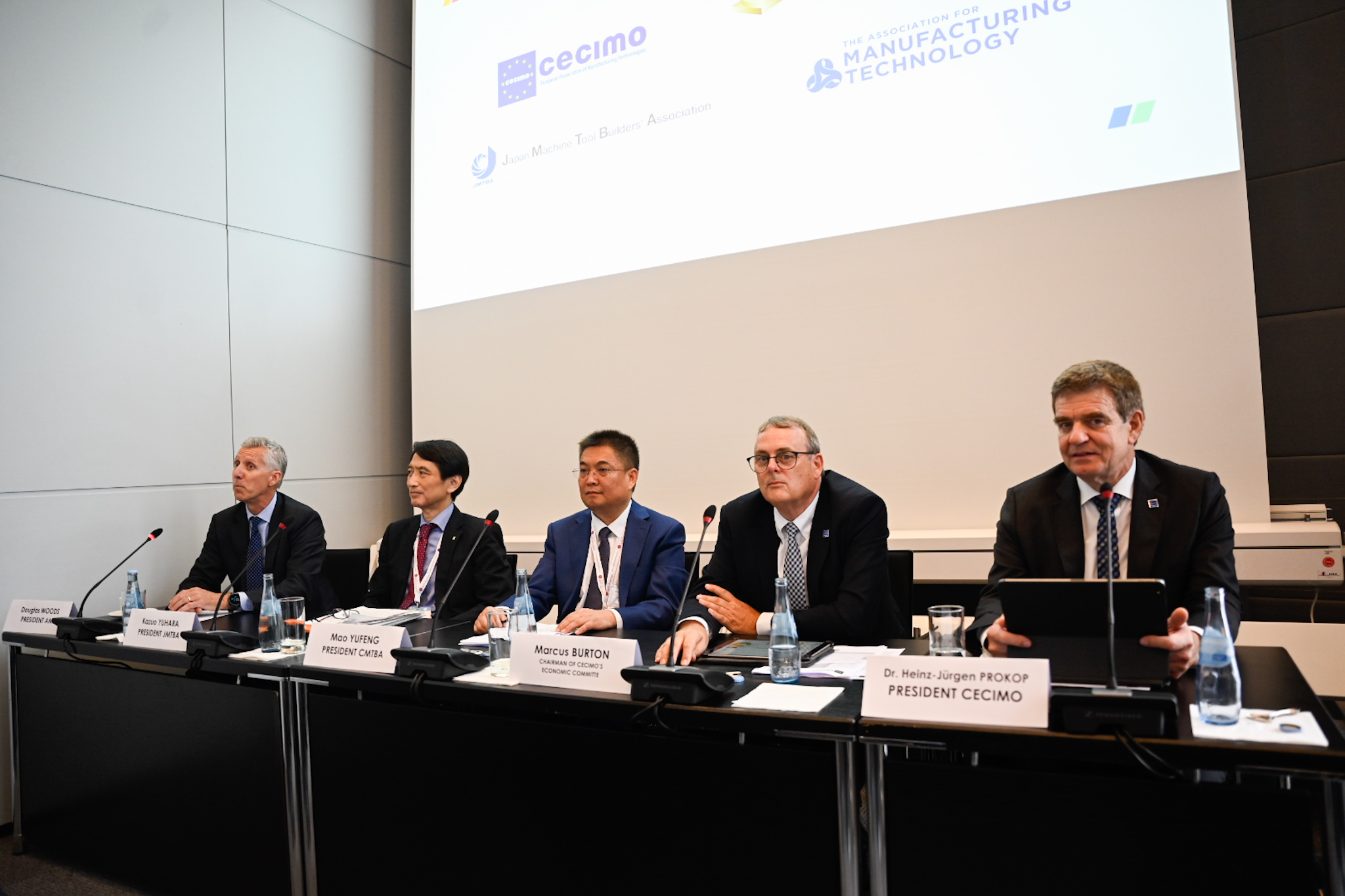Representatives from machine tool associations – whose manufacturers account for more than 80% of the global machine tool production, gathered at the world’s leading trade fair for production technology to demonstrate their resilience and strength in the face of a wide range of global challenges. Despite a stable outlook for 2023, projections for the global machine tool industry are tempered by various international and economic challenges. Building on the collective strength of the sector, collaboration, innovation and adaptability will remain key as the industry continues to navigate this evolving landscape.
“At a time of profound political and economic uncertainty, the promotion of international cooperation is imperative” underlined Dr Heinz Jürgen Prokop, CECIMO’s President, in his opening remarks at the CECIMO’s Press Conference at EMO Hannover 2023. The event united machine tool industry leaders from the United States, China, Japan and Europe.
Mr Marcus Burton, Chairman of CECIMO’s Economic Committee, highlighted CECIMO’s commitment not only to lobbying for favourable conditions for the sector, but also to fostering international cooperation with machine tool associations around the world. In that context, he also unveiled key insights from CECIMO’s recently published Global Machine Tool Report 2022, which could not have been produced without such cooperation. Based on the latest database update, Mr Burton highlighted that Global MT (machine tools) production reached a level of 79.2 billion EUR in 2022, reflecting an annual production increase of 11.9%. In the same year, MT production in the CECIMO countries recorded an increase in MT production of 12.8% and, with a level of 25.3 billion EUR, CECIMO maintained its share of 32% of global MT production. On the consumption side, CECIMO countries accounted for almost a quarter of global MT consumption, with a total value of around 18.7 billion EUR in 2022 (+25% compared to 2021).
During his presentation, Mr Burton, also revealed the latest estimates for 2023 for global and European MT production. While he highlighted that MT production in the CECIMO countries is expected to grow by around 5.5% to reach a level of almost 27 billion EUR in 2023, global MT production is expected to remain more stable, slightly below the 2022 level. In his concluding remarks, he pointed out that “In light of current developments, we have slightly downgraded our expectations. Nevertheless, we remain optimistic about the positive growth in European MT production in 2023 and our initial indications for 2024 are positive“. However, he also highlighted the significant challenges on the horizon, including the headwinds of slowing global economic growth, rising interest rates and geopolitical shifts resulting from the ongoing conflict in Ukraine. These factors collectively inject a notable degree of uncertainty into the short-term demand landscape for the machine tool industry.
In reference to the Chinese machine tools sector, Mr Mao Yufeng, President of China Machine Tool & Tool Builders’ Association (CMTBA), pointed out that “from January to July 2023, sales of metal cutting machines dropped by 4.3% to 10.76 billion USD compared to last year. On the other hand, sales of metal forming machines went up by 6.9% to 6.16 billion USD”. He also stated that 2023 has witnessed heightened endeavours in industrial restructuring and shifts within China’s machine tool consumer market. Among others, this includes a decline in overall automobile production, but a notable increase in the use of new energy vehicles. In addition to shifts in consumer markets, he highlighted several significant challenges that contribute to the uncertainty surrounding the outlook for the machine tool sector. These challenges include a fragile economic recovery, persistent inflation, financial market instability and increasing debt pressures.
In light of Japanese metal cutting MT sector, Mr Kazuo Yuhara, President of Japan’s Machine Tool Builders’ Association (JMTBA) highlights remarkable growth for the Japanese metal cutting machine tools sector in 2022. Total orders surged to a record-breaking 1,759.6 billion yen, increased by 14.2% from the previous year. Production of metal-cutting machine tools increased by 20.5% in 2022 over the previous year to 1,078.8 billion yen, with a strong growth trend in both exports and imports levels. Looking at the most recent period (January-July 2023), he noted the decline in order volumes for metal-cutting machine tools, but highlighted positive expectations for the impact on demand of investments in green, digital and resilience-related areas.
Looking at the American machine tools industry, Mr Douglas K. Woods, President of AMT – the Association for Manufacturing Technology in the USA, emphasised continued stable conditions for the American machine tools industry in 2023 and 2024, following a year of near average consumption, totalling 9.6 billion in 2022 USD. In 2023, the effects of the tightening of US monetary policy become apparent, leading to a slight decline in machine tool consumption, he added. However, indicators for 2024 suggest a recovery in machine tool production and imports, while exports stabilise, leading to an increase in consumption.


